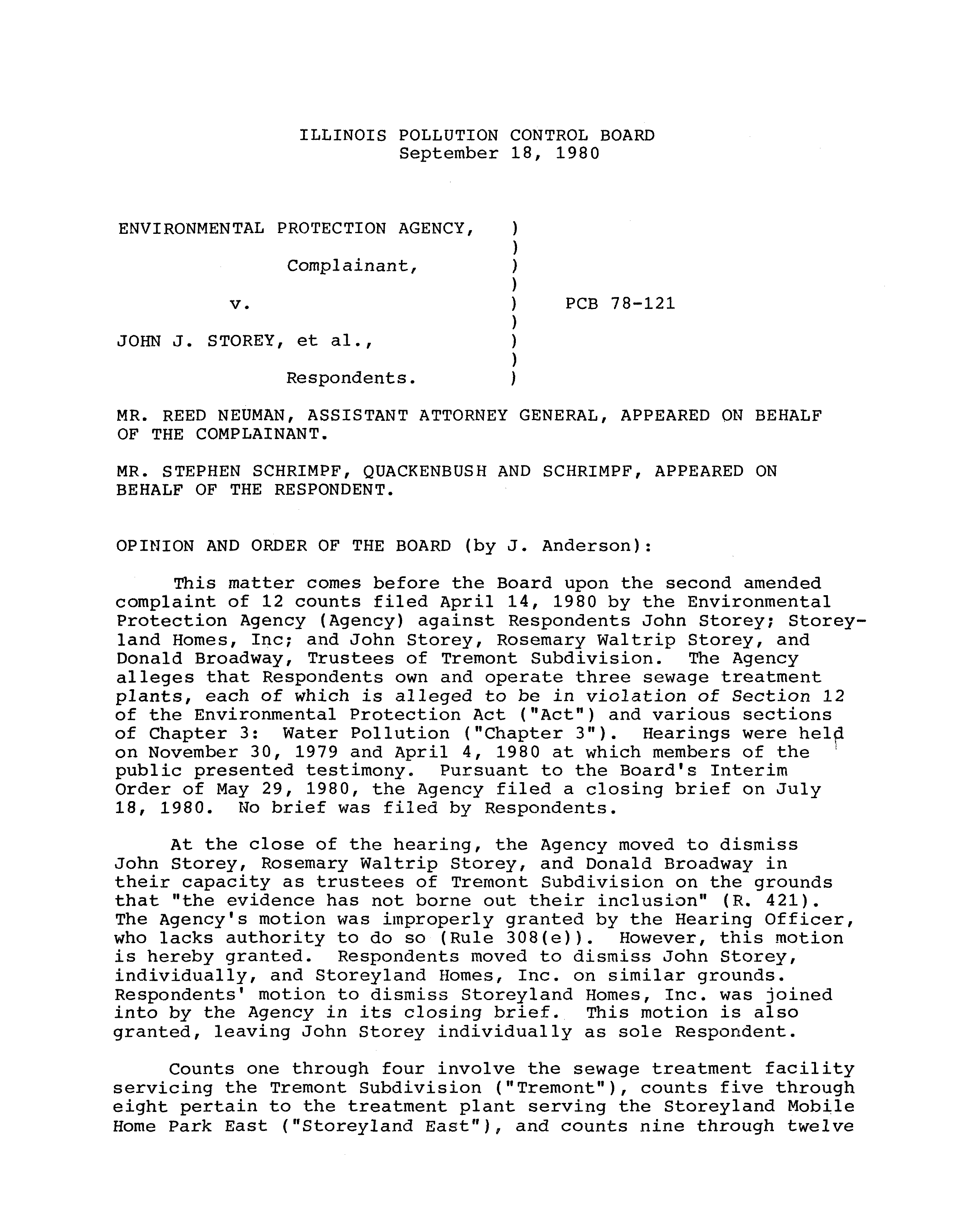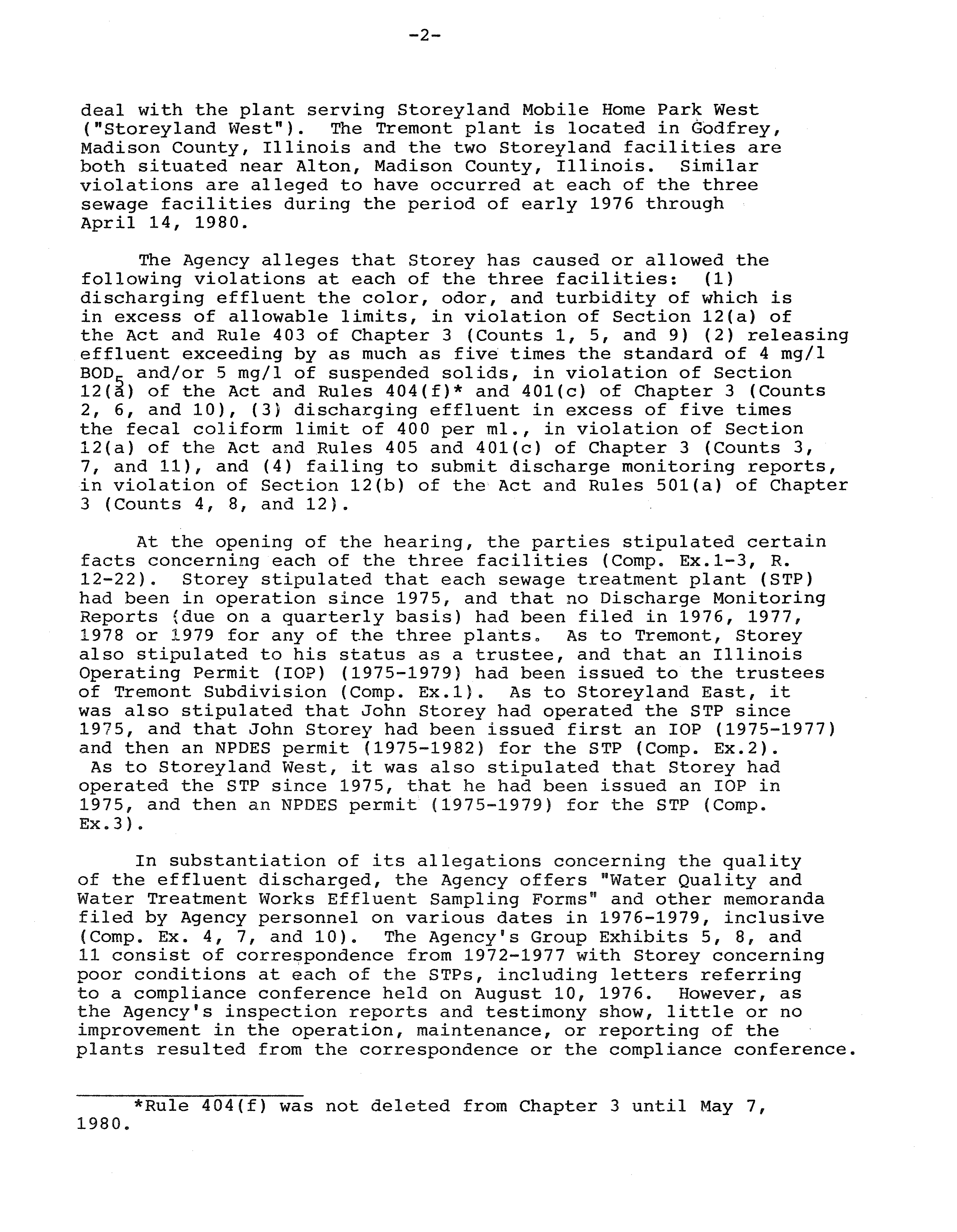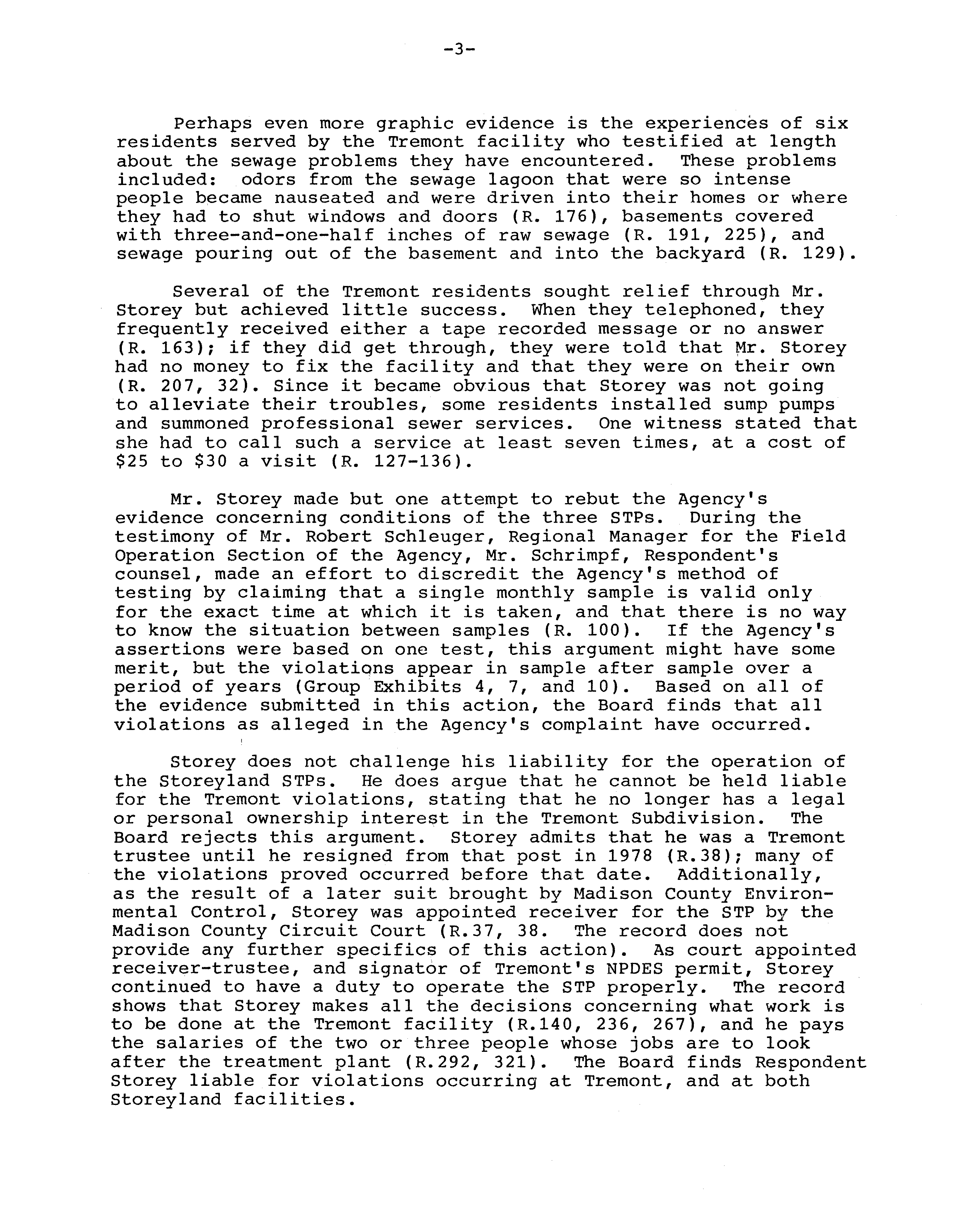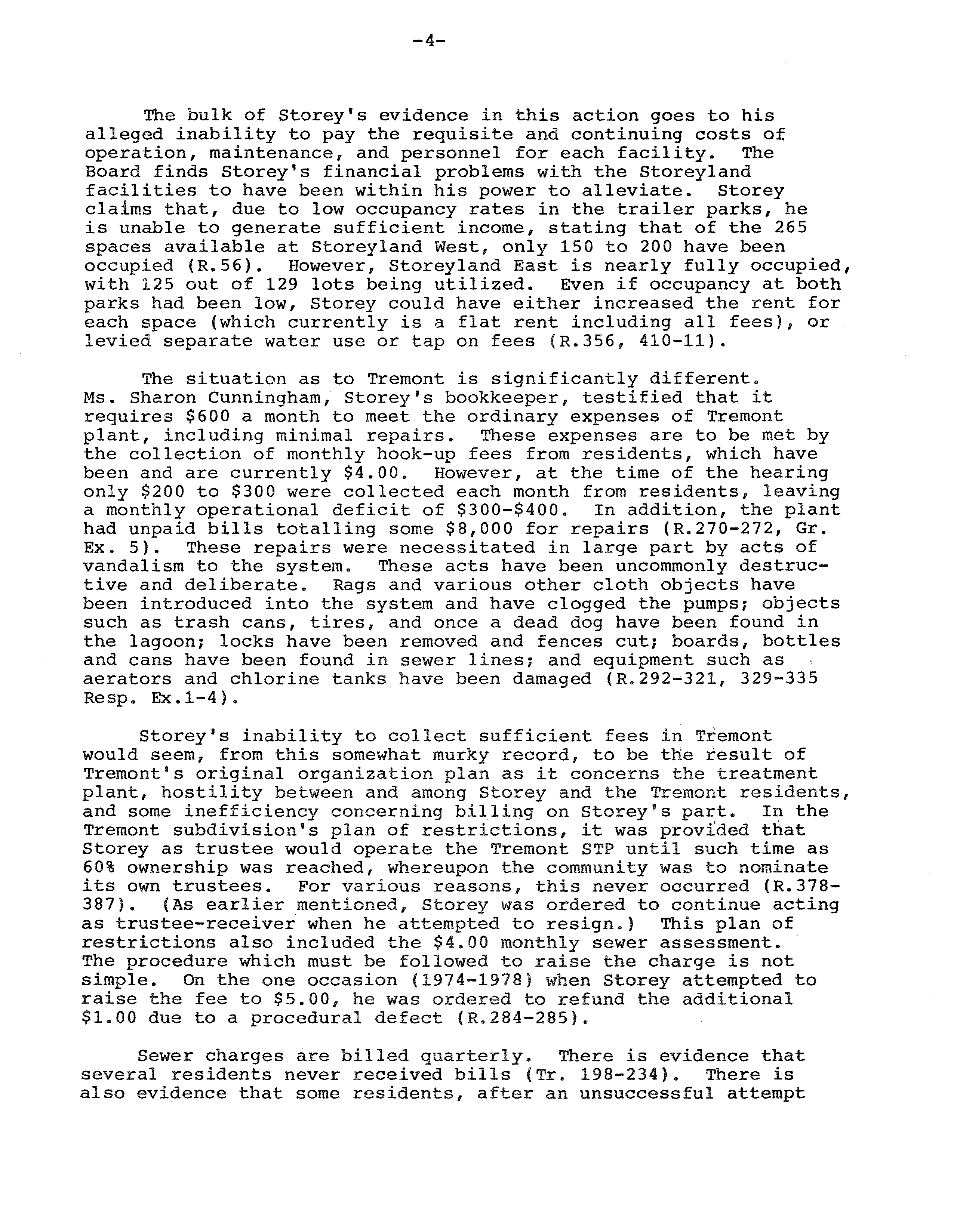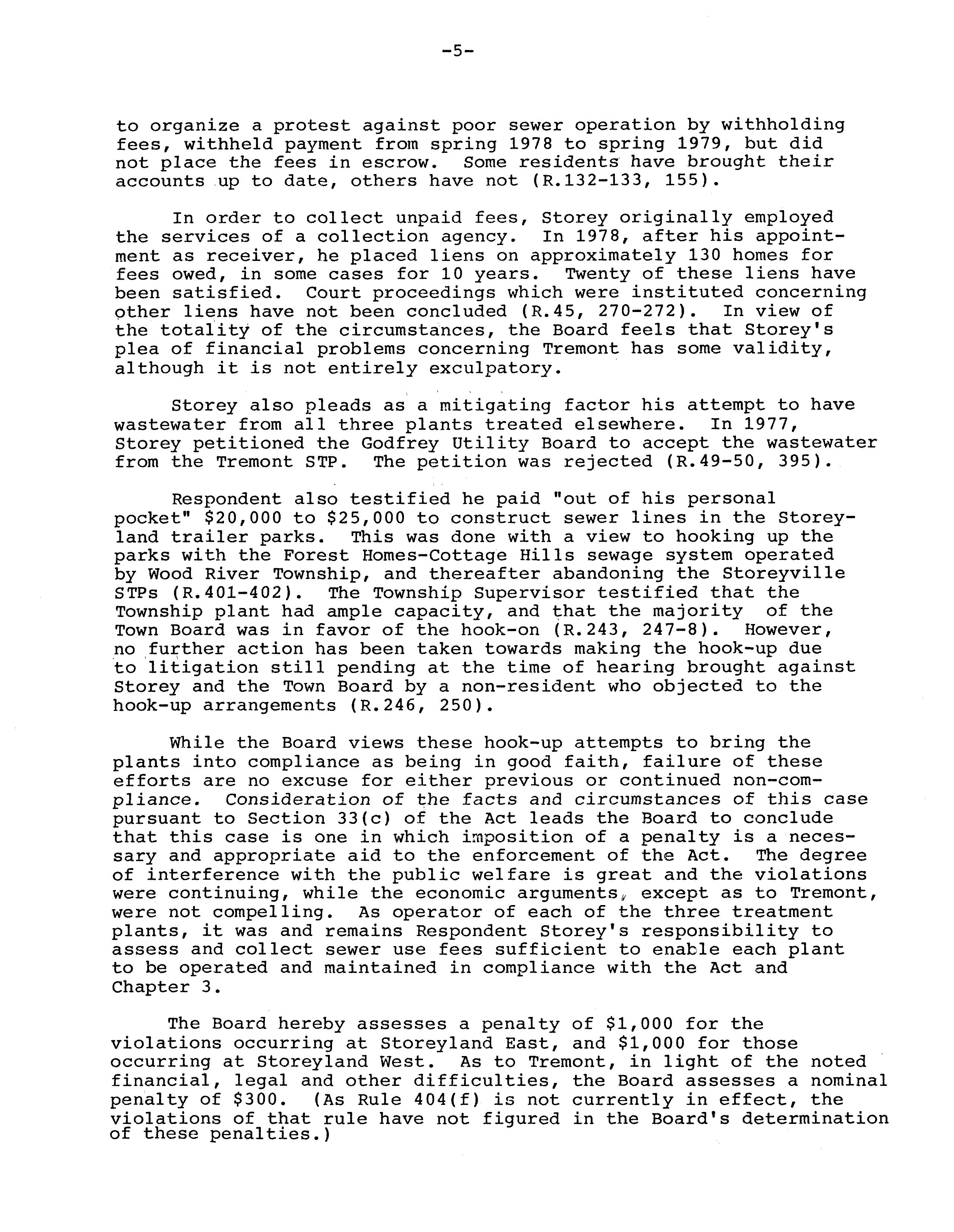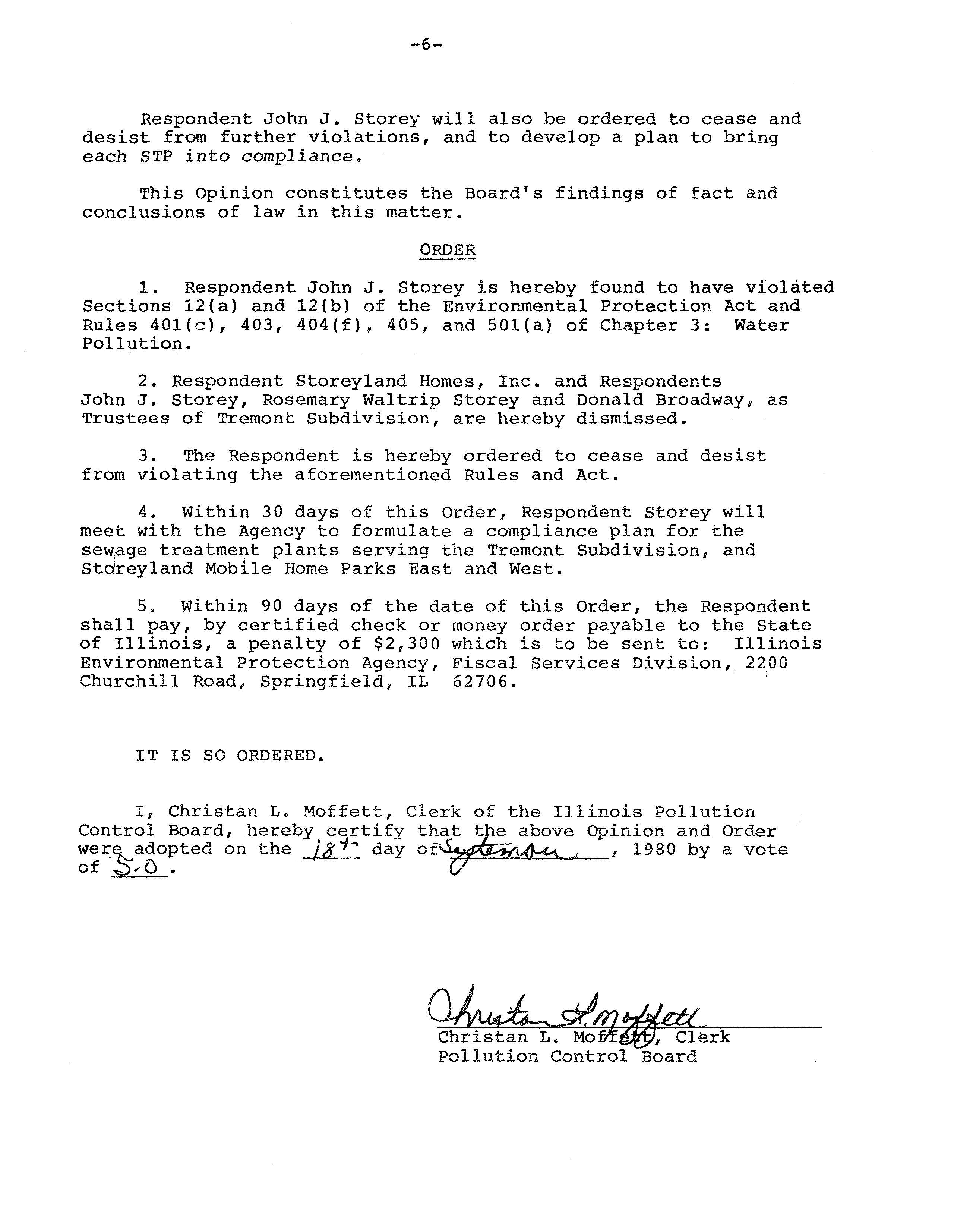ILLINOIS POLLUTION CONTROL BOARD
September 18,
1980
ENVIRONMENTAL PROTECTION AGENCY,
Complainant,
v.
)
PCB 78—121
JOHN J. STOREY,
et
a?.,
Respondents.
MR. REED NEUMAN, ASSISTANT ATTORNEY GENERAL, APPEARED
ON
BEHALF
OF THE COMPLAINANT.
MR. STEPHEN SCHRIMPF, QUACKENBUSH AND SCHRIMPF, APPEARED ON
BEHALF OF THE RESPONDENT.
OPINION AND ORDER OF THE BOARD
(by J.
Anderson):
This matter comes before the Board upon the second amended
complaint of 12 counts filed April
14,
1980 by the Environmental
Protection Agency (Agency)
against Respondents John Storey;
Storey—
land Homes, mc;
and John Storey, Rosemary Waltrip Storey, and
Donald Broadway, Trustees of Tremont Subdivision.
The Agency
alleges that Respondents own and operate three sewage treatment
plants,
each of which
is alleged to be in violation of Section 12
of the Environmental Protection Act (“Act”)
and various sections
of Chapter
3:
Water Pollution (“Chapter 3”).
Hearings were helçl
on November 30,
1979 and April
4, 1980 at which members of the
public presented testimony.
Pursuant to the Board’s Interim
Order of May 29,
1980, the Agency filed a closing brief on July
18,
1980.
No brief was filed by Respondents.
At the close of the hearing,
the Agency moved to dismiss
John Storey,
Rosemary Waltrip Storey, and Donald Broadway in
their capacity as trustees of Trernont Subdivision on the grounds
that “the evidence has not borne out their inclusion”
(R.
421).
The Agency’s motion was improperly granted by the Hearing Officer,
who lacks authority to do so
(Rule 308(e)).
However, this motion
is hereby granted.
Respondents moved to dismiss John Storey,
individually, and Storeyland Homes,
Inc. on similar grounds.
Respondents’ motion to dismiss Storeyland Homes,
Inc. was joined
into by the Agency in its closing brief.
This motion is also
granted,
leaving John Storey individually as sole Respondent.
Counts one through four involve the sewage treatment facility
servicing the Tremont Subdivision (“Tremont”), counts five through
eight pertain to the treatment plant serving the Storeyland Mobile
Home Park East (“Storeyland East”), and counts nine through twelve
—2—
deal with the plant serving Storeyland Mobile Home Park West
(“Storeyland West”).
The Tremont plant is located in Godfrey,
Madison County,
Illinois and the two Storeyland facilities are
both situated near Alton,
Madison County,
Illinois.
Similar
violations are alleged to have occurred at each of the three
sewage facilities during the period of early 1976 through
April
14,
1980.
The Agency alleges that Storey has caused or allowed the
following violations at each of the three facilities:
(1)
discharging effluent the color,
odor,
and turbidity of which is
in excess of allowable limits,
in violation of Section 12(a) of
the Act and Rule 403 of Chapter
3
(Counts
1,
5, and 9)
(2) releasing
effluent exceeding by as much as five times the standard of
4 mg/?
BOD
and/or
5 mg/i of suspended solids, in violation of Section
12(a) of the Act and Rules 404(f)* and 401(c) of Chapter 3
(Counts
2,
6, and 10),
(3) discharging effluent in excess of five times
the fecal coliform limit of 400 per ml.,
in violation of Section
12(a) of the Act and Rules
405 and 401(c) of Chapter
3
(Counts
3,
7, and 11),
and
(4)
failing to submit discharge monitoring reports,
in violation of Section 12(b)
of the Act and Rules 501(a) of Chapter
3
(Counts
4,
8,
and 12).
At the opening of the hearing,
the parties stipulated certain
facts concerning each of the three facilities
(Comp,
Ex.1—3,
R.
12—22),
Storey stipulated that each sewage treatment plant
(STP)
had been in operation since 1975, and that no Discharge Monitoring
Reports (due on a quarterly basis) had been filed in 1976, 1977,
1978 or 1979 for any of the three plants.
As to Tremont, Storey
also stipulated to his status as a trustee, and that an Illinois
Operating Permit
(lOP)
(1975—1979) had been issued to the trustees
of Tremont Subdivision (Comp.
Ex.1).
As to Storeyland East,
it
was also stipulated that John Storey had operated the STP since
1975, and that John Storey had been issued first an lOP
(1975—1977)
and then an NPDES permit
(1975—1982)
for the STP
(Comp. Ex.2).
As to Storeyland West,
it was also stipulated that Storey had
operated the STP since 1975, that he had been issued an lOP in
1975,
and then an NPDES permit (1975—1979)
for the STP (Comp.
Ex. 3),
In substantiation of its allegations concerning the quality
of the effluent discharged,
the Agency offers “Water Quality and
Water Treatment Works Effluent Sampling Forms” and other memoranda
filed by Agency personnel on various dates in 1976-1979,
inclusive
(Comp.
Ex.
4,
7,
and 10).
The Agency’s Group Exhibits
5,
8, and
11 consist of correspondence from 1972-1977 with Storey concerning
poor conditions at each of the STPs,
including letters referring
to a compliance conference held on August 10,
1976,
However, as
the Agency’s inspection reports and testimony show, little or no
improvement in the operation, maintenance, or reporting of the
plants resulted from the correspondence or the compliance conference.
1980,
*Rule
404(f) was not deleted from Chapter
3 until May 7,
—3—
Perhaps even more graphic evidence is the experiences of six
residents served by the Tremont facility who testified at length
about the sewage problems they have encountered.
These problems
included:
odors from the sewage lagoon that were so intense
people became nauseated and were driven into their homes or where
they had to shut windows and doors
(R.
176), basements covered
with three—and-one—half inches of raw sewage
(R.
191,
225), and
sewage pouring out of the basement and into the backyard
(R.
129).
Several of the Tremont residents sought relief through Mr.
Storey but achieved little success.
When they telephoned,
they
frequently received either a tape recorded message or no answer
(R.
163);
if they did get through, they were told that Mr.
Storey
had no money to fix the facility and that they were on their own
(R.
207,
32).
Since it became obvious that Storey was not going
to alleviate their troubles,
some residents installed sump pumps
and summoned professional sewer services.
One witness stated that
she had to call such a service at least seven times, at a cost of
$25 to $30 a visit
(R.
127—136).
Mr. Storey made but one attempt to rebut the Agency’s
evidence concerning conditions of the three STPs.
During the
testimony of Mr. Robert Schleuger, Regional Manager for the Field
Operation Section of the Agency,
Mr.
Schrimpf,
Respondent’s
counsel, made an effort to discredit the Agency’s method of
testing by claiming that a single monthly sample is valid only
for the exact time at which it is taken, and that there is no way
to know the situation between samples
(R.
100).
If the Agency’s
assertions were based on one test, this argument might have some
merit, but the violations appear in sample after sample over a
period of years
(Group Exhibits
4,
7,
and 10).
Based on all of
the evidence submitted in this action, the Board finds that all
violations as alleged in the Agency’s complaint have occurred.
Storey does not challenge his liability for the operation of
the Storeyland STPs.
He does argue that he cannot be held liable
for the Tremont violations, stating that he no longer has a legal
or personal ownership interest in the Tremont Subdivision.
The
Board rejects this argument.
Storey admits that he was a Tremont
trustee until he resigned from that post in 1978
(R.38); many of
the violations proved occurred before that date.
Additionally,
as the result of a later suit brought by Madison County Environ-
mental Control, Storey was appointed receiver for the STP by the
Madison County Circuit Court
(R..37,
38.
The record does not
provide any further specifics of this action).
As court appointed
receiver-trustee, and signatOr of Tremont’s NPDES permit,
Storey
continued to have a duty to operate the STP properly.
The record
shows that Storey makes all the decisions concerning what work is
to be done at the Tremont facility (R.140,
236,
267), and he pays
the salaries of the two or three people whose jobs are to look
after the treatment plant
(R.292,
321).
The Board finds Respondent
Storey liable for violations occurring at Tremont, and at both
Storeyiand facilities.
—4—
The bulk of Storey’s evidence
in
this
action
goes
to
his
alleged inability to pay the requisite and continuing costs of
operation, maintenance, and personnel for each facility.
The
Board finds Storey’s financial problems with the Storeyland
facilities to have been within his power to alleviate.
Storey
claims that, due to low occupancy rates in the trailer parks, he
is unable to generate sufficient income, stating that of the 265
spaces available at Storeyland West, only 150 to 200 have been
occupied
(R.56).
However, Storeyland East is nearly fully occupied,
with 125 out of 129 lots being utilized.
Even if occupancy at both
parks had been low, Storey could have either increased the rent for
each space
(which currently is a flat rent including all
fees), or
levied separate water use or tap on fees
(R.356,
410-11).
The situation as to Tremont is significantly different.
Ms. Sharon Cunningham, Storey’s bookkeeper, testified that it
requires $600 a month to meet the ordinary expenses of Tremont
plant, including minimal
repairs.
These expenses are to be met by
the collection of monthly hook—up fees from residents, which have
been and are currently $4.00.
However, at the time of the hearing
only $200 to $300 were collected each month
from residents,
leaving
a monthly operational deficit of $300-$400.
In addition, the plant
had unpaid bills totalling some $8,000 for repairs
(R,270—272,
Gr,
Ex.
5).
These repairs were necessitated in large part by acts of
vandalism to the system.
These acts have been uncommonly destruc-
tive and deliberate.
Rags and various other cloth objects have
been introduced into the system and have clogged the pumps; objects
such as trash cans, tires,
and once a dead dog have been found in
the lagoon; locks have been removed and fences cut; boards, bottles
and cans have been found in sewer lines;
and equipment such as
aerators and chlorine tanks have been damaged
(R,292—321, 329—335
Resp. Ex.1—4).
Storey’s inability to collect sufficient fees in Tremont
would seem,
from this somewhat murky record, to be the result of
Tremont’s original organization plan as it concerns the treatment
plant, hostility between and among Storey and the Tremont residents,
and some inefficiency concerning billing on Storey’s part.
In the
Tremont subdivision’s plan of restrictions, it was provided that
Storey as trustee would operate the Tremont STP until such time as
60
ownership was reached, whereupon the community was to nominate
its own trustees,
For various reasons,
this never occurred (R.378—
387).
(As earlier mentioned,
Storey was ordered to continue acting
as trustee—receiver when he attempted to resign.)
This plan of
restrictions also included the $4.00 monthly sewer assessment,
The procedure which must be followed to raise the charge is not
simple.
On the one occasion
(1974—1978) when Storey attempted to
raise the fee to $5.00, he was ordered to refund the additional
$1.00 due to a procedural defect (R,284—285),
Sewer charges are billed quarterly,
There is evidence that
several residents never received bills
(Tr.
198—234).
There is
also evidence that some residents,
after an unsuccessful attempt
—5—
to organize a protest against poor sewer operation by withholding
fees, withheld payment from spring 1978 to spring 1979, but did
not place the fees in escrow.
Some residents have brought their
accounts up to date,
others have not
(R.132—133,
155).
In order to collect unpaid fees, Storey originally employed
the services of a collection agency.
In 1978, after his appoint-
ment as receiver, he placed liens on approximately 130 homes for
fees owed,
in some cases for 10 years.
Twenty of these liens have
been satisfied.
Court proceedings which were instituted concerning
other liens have not been concluded
(R.45,
270—272).
In view of
the totality of the circumstances, the Board feels that Storey’s
plea of financial problems concerning Tremont has some validity,
although it is not entirely exculpatory.
Storey also pleads as a mitigating factor his attempt to have
wastewater from all three plants treated elsewhere.
In 1977,
Storey petitioned the Godfrey Utility Board to accept the wastewater
from the Tremont STP.
The petition was rejected
(R.49—50, 395).
Respondent also testified he paid “out of his personal
pocket” $20,000 to $25,000 to construct sewer
lines in the Storey—
land trailer parks.
This was done with a view to hooking up the
parks with the Forest Homes-Cottage Hills sewage system operated
by Wood River Township,
and thereafter abandoning the Storeyville
STPs
(R.401—402).
The Township Supervisor testified that the
Township plant had ample capacity, and that the majority
of the
Town Board was in favor of the hook-on (R.243,
247—8).
However,
no further action has been taken towards making the hook—up due
to litigation still pending at the time of hearing brought against
Storey and the Town Board by a non—resident who objected to the
hook—up arrangements
(R.246,
250).
While the Board views these hook-up attempts to bring the
plants into compliance as being
in good faith,
failure of these
efforts are no excuse for either previous or continued non—com-
pliance.
Consideration of the facts and circumstances of this case
pursuant to Section 33(c) of the Act leads the Board to conclude
that this case
is one in which imposition of a penalty is a neces-
sary and appropriate aid to the enforcement of the Act.
The degree
of interference with the public welfare is great and the violations
were continuing, while the economic arguments
except as to Tremont,
were not compelling.
As operator of each of the three treatment
plants, it was and remains Respondent Storey’s responsibility to
assess and collect sewer use fees sufficient to enable each plant
to be operated and maintained in compliance with the Act and
Chapter 3.
The Board hereby assesses a penalty of $1,000 for the
violations occurring at Storeyland East,
and $1,000 for those
occurring at Storeyland West.
As to Tremont, in light of the noted
financial,
legal and other difficulties, the Board assesses a nominal
penalty of $300.
(As Rule 404(f) is not currently in effect,
the
violations of that rule have not figured in the Board’s determination
of these penalties.)
—6—
Respondent John J. Storey will also be ordered to cease and
desist from further violations, and to develop a plan to bring
each STP into compliance.
This Opinion constitutes the Board’s findings of fact and
conclusions of law in this matter.
ORDER
1.
Respondent John J. Storey is hereby found to have vIolated
Sections 12(a) and 12(b) of the Environmental Protection Act and
Rules 401(c),
403,
404(f),
405, and 501(a)
of Chapter
3:
Water
Pollution.
2. Respondent Storeyland Homes,
Inc. and Respondents
John J.
Storey, Rosemary Waltrip Storey and Donald Broadway,
as
Trustees of Tremont Subdivision, are hereby dismissed.
3.
The Respondent is hereby ordered to cease and desist
from violating the aforementioned Rules and Act.
4.
Within 30 days of this Order,
Respondent Storey will
meet with the Agency to formulate a compliance plan for the
sewage treatment plants serving the Tremont Subdivision, and
Stdreyland Mobile Home Parks East and West.
5.
Within
90 days of the date of this Order,
the Respondent
shall pay, by certified check or money order payable to the State
of Illinois,
a penalty of $2,300 which is to be sent to:
Illinois
Environmental Protection Agency, Fiscal Services Division, 2200
Churchill Road,
Springfield,
IL
62706.
IT IS SO ORDERED.
I, Christan L.
Moffett, Clerk of the Illinois Pollution
Control Board, hereby certify that t e above Opinion and Order
wer~adoptedon the
~
day ~
1980 by a vote
a~dL
Christan L. Mo
~
Clerk
Pollution Control Board
